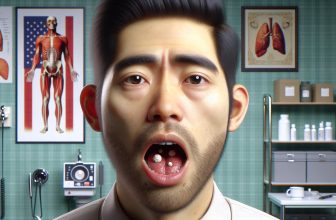
Ever looked in the mirror and noticed your tongue’s got more waves than an ocean? If you’ve ever wondered about the wavy tongue meaning, you’re not alone. It’s one of those curious bodily quirks that can leave you scratching your head—or in this case, your tongue.
But don’t worry, I’m here to dive into the depths of what those ripples might signify. From dietary deficiencies to dental impressions, we’ll explore the various causes and what they could mean for your overall health. So, let’s get to the bottom of this tongue-twisting mystery, shall we?
Key Takeaways
- Wavy Tongue Causes: A wavy tongue can be caused by genetic factors like hereditary conditions or congenital disorders, as well as environmental triggers such as chronic dehydration, nutritional deficiencies, and dental issues.
- Symptoms: Key physical characteristics include scalloping on the edges, swelling, changes in color, and texture differences. Secondary symptoms may involve discomfort, pain, dry mouth, bad breath, and potential speech difficulties.
- Diagnosis: Diagnosing a wavy tongue involves a thorough medical examination, reviewing medical history, lifestyle factors, and conducting diagnostic tests like blood tests, imaging, biopsies, and allergy tests.
- Treatment Options: Treatments range from home remedies like proper hydration and good oral hygiene to medical interventions, including dental consultations, vitamin supplements, medications, and orthodontic treatments.
- Preventative Measures: Preventing a wavy tongue involves maintaining a balanced diet, regular dental check-ups, stress reduction, staying hydrated, avoiding irritants, and using mouthguards if necessary.
- When to See a Doctor: Seek medical advice if you experience pain, burning, significant tongue swelling, discoloration, difficulty moving the tongue, fever, sore throat, or any other serious symptoms.
Causes of a Wavy Tongue
Exploring the causes of a wavy tongue reveals various contributing factors. I’ll delve into genetic influences and environmental conditions that may lead to this phenomenon.
Genetic Factors
Genetics can play a significant role in developing a wavy tongue. Specific hereditary conditions may contribute to this trait. For instance, individuals with a family history of certain craniofacial anomalies might exhibit a wavy tongue.
Congenital disorders often include symptoms affecting oral structures. People with Ehlers-Danlos syndrome, a group of connective tissue disorders, sometimes show this type of tongue morphology. A wavy tongue might be present due to the genetic nature of such disorders.
Genetic predisposition means some may inherit the tendency towards a wavy tongue. Conversely, others might not manifest this trait unless specific conditions are met. Nonetheless, understanding these genetic factors helps in identifying potential causes and linking them to familial patterns.
Environmental Triggers
Several environmental factors could result in a wavy tongue. Chronic dehydration often leads to changes in the tongue’s appearance. Recurrent lack of sufficient hydration affects tissue elasticity, contributing to a wavy appearance.
Nutritional deficiencies also play a role. Deficiency in essential vitamins and minerals, particularly vitamin B12 and iron, might cause noticeable changes in tongue morphology. Addressing dietary gaps can often mitigate these effects.
Dental structures and habits significantly impact the tongue’s shape. Ill-fitting dentures or consistent teeth clenching might leave impressions, leading to a wavy pattern over time. Ensuring proper dental care could therefore prevent these indentations.
Exploring these environmental triggers alongside genetic factors provides a comprehensive understanding of why a wavy tongue occurs. Recognizing and addressing these influences aids in managing this condition effectively.
Symptoms Associated with a Wavy Tongue

A wavy tongue can signal various underlying issues. Observing the tongue’s characteristics and related symptoms is crucial for understanding and managing this condition.
Physical Characteristics
A key sign of a wavy tongue is scalloping on the edges. The indentations resemble teeth marks and can vary in depth and length. Often, the tongue appears swollen, especially around the scalloped edges. Changes in color might also occur, with some areas looking red or pale. Texture differences such as increased smoothness or roughness on the tongue’s surface might be present.
Horizontal lines or cracks may become visible on the tongue. These lines usually run from side to side, adding to the wavy appearance. Sometimes, bumps or ridges appear, further altering the tongue’s natural shape. When the tongue is examined, it’s often apparent that these physical changes coincide with other symptoms, highlighting the interconnected nature of the condition.
Secondary Symptoms
Individuals with a wavy tongue might experience discomfort or pain. This discomfort can be more pronounced when eating certain foods. Soreness in the tongue, particularly near the scalloped edges, is common. Additionally, some may feel a burning sensation, which could be linked to other oral conditions.
A wavy tongue often appears with dry mouth symptoms. Reduced saliva levels can lead to a dry or sticky feeling in the mouth. This dryness might also cause bad breath. In some cases, speech difficulties can arise. Pronouncing words or maintaining clear speech might become challenging due to the tongue’s altered shape.
Monitoring these symptoms is essential for determining the root cause of a wavy tongue and finding the appropriate treatment. Addressing both physical characteristics and secondary symptoms provides a comprehensive approach to managing this condition.
Diagnosing a Wavy Tongue

Identifying the underlying cause of a wavy tongue involves a few steps. A comprehensive diagnosis ensures the right treatment and management.
Medical Examination
A healthcare provider carries out a physical examination. They look at the tongue’s surface and edges for any abnormalities. Symmetry, color, and texture are assessed. A discussion about symptoms like discomfort or pain also takes place.
A review of medical history happens next. The provider asks about recent illnesses, injuries, and chronic conditions. This information offers clues to potential causes.
Lifestyle factors come under scrutiny too. Nutritional habits, hydration levels, and usage of tobacco or alcohol are examined. These factors can influence tongue health.
The provider may also check for signs related to systemic issues. Conditions like hypothyroidism or diabetes often manifest in the tongue. A thorough examination ensures all potential causes are considered.
Diagnostic Tests
Blood tests are common in diagnosing a wavy tongue. They help detect nutritional deficiencies like iron or B12. Identifying these deficiencies can lead to straightforward treatments.
Imaging tests might be ordered if structural issues or tumors are suspected. X-rays or MRIs provide detailed images of the tongue and surrounding structures. These images reveal any hidden abnormalities.
Biopsy involves taking a small sample of tongue tissue. It’s analyzed for signs of infection or malignancy. This test is essential if the provider suspects something serious.
Allergy tests could be done if allergic reactions are considered a potential cause. Skin prick tests or blood tests identify specific allergens. Pinpointing these helps manage and prevent reactions.
Working through these diagnostic steps ensures a precise identification of the cause, aiding in effective treatment planning.
Treatment Options for a Wavy Tongue
Effective treatments for a wavy tongue depend on the underlying cause. Remedies can range from simple home-based solutions to more intensive medical treatments and even preventative measures.
Home Remedies
Simple lifestyle changes and oral hygiene can help manage a wavy tongue. Starting with hydration, drinking plenty of water can prevent dehydration, which is a common cause. Chewing sugar-free gum stimulates saliva production, aiding in a healthier tongue. Dietary adjustments play a crucial role too; consuming foods rich in vitamins and minerals, like leafy greens, nuts, and fish, can significantly improve tongue health. Avoid irritants such as tobacco and alcohol, which can exacerbate the condition. I also recommend practicing good oral hygiene. Regular brushing and using an antibacterial mouthwash can prevent infections that might cause tongue waviness. Gentle tongue cleaning using a scraper removes bacteria and dead cells, promoting a healthier surface.
Medical Treatments
Persistent or severe cases require professional medical treatments. Dental consultation is essential to check for misaligned teeth or other dental issues. Orthodontic treatments, such as braces or aligners, may be recommended. Vitamin deficiencies are another common cause, so a healthcare provider might prescribe vitamin supplements. Steroids or anti-inflammatory medications might be used if an autoimmune issue is detected. Sometimes, tongue biopsy helps rule out more severe conditions like oral cancer. Allergies can also cause tongue changes; hence, allergy shots or medications could be suggested. Dental appliances like mouthguards can help if teeth grinding is identified as a cause. Regular monitoring by a healthcare provider ensures effective management and adaptation of the treatment plan as required.
Preventative Measures
Preventative steps ensure a wavy tongue doesn’t recur. Maintaining a balanced diet that includes essential vitamins and minerals is vital. Regular dental check-ups can catch early signs of dental issues that may cause tongue waviness. Reducing stress through techniques like meditation or exercise can prevent teeth grinding, a common cause. Staying hydrated keeps the tongue’s surface healthy. Avoiding smoking and excessive alcohol use eliminates major irritants. Practicing good oral hygiene consistently reduces the risk of infections. Using mouthguards at night can prevent damage from teeth grinding. By implementing these measures, the likelihood of experiencing a wavy tongue is significantly reduced.
When to See a Doctor
Unusual or persistent changes in your tongue, like waves, need medical attention. If tongue waves come with pain or burning, consult a healthcare provider. Visible changes such as tongue discoloration or significant swelling should not be ignored. Difficulty moving the tongue may signal a health issue that requires professional evaluation.
Experiencing additional symptoms like fever or a sore throat along with a wavy tongue could indicate an infection. If these symptoms persist, seek medical advice promptly. Breathing or swallowing difficulties paired with a wavy tongue warrant immediate medical care. Chronic issues like recurring tongue waves might hint at an underlying condition needing further investigation.
Regular dental visits can help identify any oral health issues early on. Sudden changes in the tongue’s appearance should trigger a medical consultation to rule out serious conditions. Monitoring your tongue health is crucial for overall well-being, and seeking medical advice when unusual changes occur ensures timely intervention and care.
Conclusion
Recognizing and addressing a wavy tongue early can lead to more effective management and better overall health. It’s crucial to pay attention to any unusual changes and seek medical advice when necessary. By maintaining a balanced diet, scheduling regular dental check-ups, and employing stress reduction techniques, we can promote a healthier tongue. Remember that early intervention is key to preventing more serious health issues. Stay proactive about your oral health and don’t hesitate to consult with healthcare professionals if you notice persistent changes in your tongue.
Frequently Asked Questions
What causes a wavy tongue?
A wavy tongue can be caused by several factors, including dental issues, nutritional deficiencies, stress, and underlying health conditions. Identifying the exact cause often involves examining other symptoms and sometimes seeking professional medical advice.
What are the common symptoms of a wavy tongue?
Common symptoms of a wavy tongue include indentations along the tongue’s edges, changes in texture, and sometimes discomfort or pain. These can be accompanied by secondary symptoms like changes in appetite or stress levels.
How is a wavy tongue diagnosed?
A wavy tongue is typically diagnosed through a physical examination by a healthcare provider or dentist. They may also consider your medical history and any accompanying symptoms to determine the cause.
What are the treatment options for a wavy tongue?
Treatment options for a wavy tongue depend on the underlying cause. They may include addressing nutritional deficiencies, dental issues, stress management, or treating any underlying health conditions.
How can I prevent a wavy tongue?
Preventative measures include maintaining a balanced diet, regular dental check-ups, and managing stress. Good oral hygiene and monitoring your overall health can also help prevent a wavy tongue.
When should I seek medical attention for a wavy tongue?
You should seek medical attention if you notice unusual or persistent changes in your tongue, especially if accompanied by pain, burning, discoloration, swelling, difficulty moving the tongue, fever, sore throat, or breathing and swallowing difficulties.
How important are regular dental visits for tongue health?
Regular dental visits are crucial for monitoring oral health, including tongue health. They help in the early identification of oral health issues and ensure timely intervention when unusual changes occur.
Can stress cause changes in the tongue?
Yes, stress can lead to changes in the tongue, including the development of a wavy appearance. Stress management techniques may help improve tongue health and overall well-being.







 MY GUMS HAVE NEVER LOOKED BETTER!
MY GUMS HAVE NEVER LOOKED BETTER!
